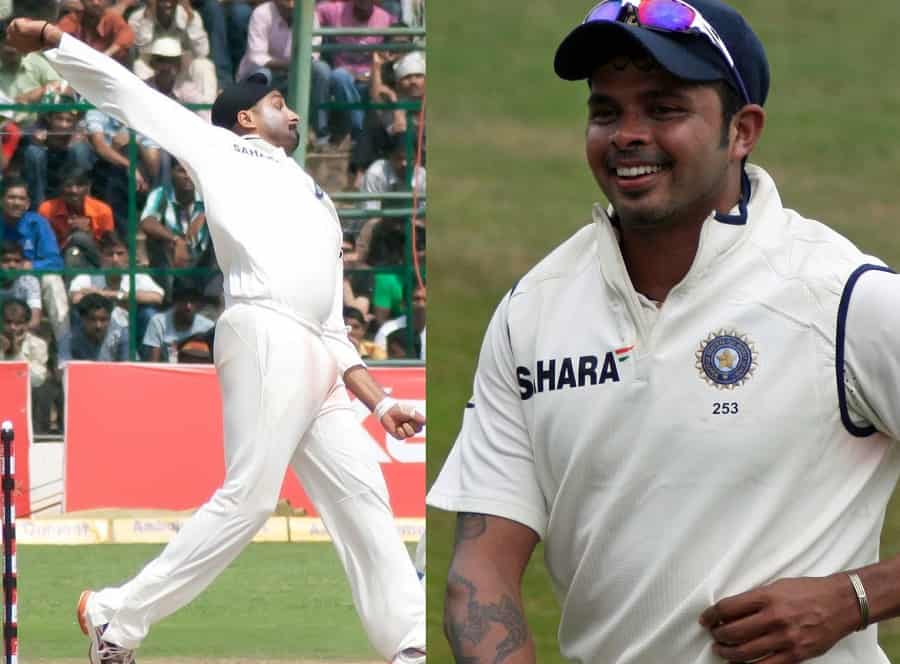Harbhajan Singh and S Sreesanth are two former Indian cricketers who bowled for their country with distinction. They were also involved in an on-field fight during the Indian Premier League that turned into the tournament’s first ever major player trouble.
When did the Harbhajan-Sreesanth controversy happen?
The Indian Premier League was still in its very nascent stages when Harbhajan Singh and S Sreesanth got involved in one of the biggest player controversies of all times in the IPL.
This occurred in a match between the Mumbai Indians and the then-called Kings XI Punjab (now Punjab Kings or PBKS) in the first ever edition of the Indian Premier League. The match was played on April 25, 2008 at the PCA Stadium in Mohali and Kings XI Punjab had just relegated the Mumbai Indians to their third successive loss under the leadership of the stand-in captain Harbhajan.
What actually transpired between Harbhajan & Sreesanth?
It was the first edition of the IPL and there was a different kind of pressure on all the teams to win matches. Typically, before the IPL, cricketers used to be under pressure from their fans to perform but in the IPL, it wasn’t just the fans but the team-owners who also wielded a lot of that on the players.
They had, after all, purchased not just the teams by paying large sums of money, but also spent a fortune in selecting players. Harbhajan Singh, for instance, was paid INR 3 crore for six weeks of effort in that opening edition of the IPL – a kind of sum not seen before in any form of cricket before that.
With that being the case, the Harbhajan Singh-led Mumbai Indians went into their third game of the season with two defeats from two matches. When Kings XI Punjab piled up 182 on the back of a Kumar Sangakkara’s near-century and Mumbai fell to a 66 run-loss to make it three in a row, it was evident that the team in general and Harbhajan Singh, who was leading them in the absence of Sachin Tendulkar, felt the pressure.
On the other hand, Punjab seamer Sreesanth had had a good game having bagged two wickets but according to reports, he had tried to get under the skins of the Mumbai Indians players with his overtly aggressive verbals. This wasn’t taken too kindly by Harbhajan even as Mumbai hurtled towards a massive and third successive defeat.
At the end of the game as the players and team owners mixed around, Sreesanth was seen crying inconsolably as fellow team player VRV Singh tried to console him. Captain Sangakkara joined them to inquire about his well-being before the cameras panned away.
While the fans were left wondering what had transpired, it was later revealed that as Sreesanth had shook hands with Harbhajan Singh and said, “hard luck” on the loss, the Mumbai Indians skipper had ended up slapping him.
How did the IPL respond to the incident?
The Kings XI Punjab lodged a complaint against Harbhajan Singh with the IPL. In response, the match referee for this game was the former Indian wicket-keeper Farokh Engineer and he immediately banned Harbhajan for the rest of the tournament after finding him guilty of level 4.2 offence.
This was confirmed by the tournament commissioner and chairman, Lalit Modi.
The level 4.2 offence was related to physically assaulting a player or support staff, match official or fans and came under the ICC Code of Conduct.
Modi also said that Sreesanth had been warned about his aggressive behaviour and on-field conduct.
Harbhajan was also fined 100% of his match fee and what the ban also meant was that he wasn’t eligible to receive his payment for the rest of the tournament. His services had been bought in the IPL auction for a whopping INR 3.4 crores.
What did the BCCI do after the Harbhajan-Sreesanth controversy?
The BCCI, who had vehemently defended Harbhajan Singh during the Monkeygate controversy, was left with no option but to take matters in their own hands this time around. In addition to the penalty that IPL imposed on Harbhajan, the BCCI also banned the off-spinner for five ODIs under the 3.1 level of offence.
This meant that Harbhajan missed the tour of Bangladesh that followed and the first two matches of the Asia Cup.
Sreesanth was also warned by the BCCI and asked to mend his behaviour.
Is there video evidence of what transpired between Harbhajan and Sreesanth?
According to the tournament organisers there is video evidence of this Slapgate controversy which was used during the hearing at the end of the encounter.
It was watched by Modi, Engineer, Neil Maxwell (the KXIP CEO), Sreesanth, Harbhajan, Mumbai Indians coach Lalchand Rajput and the managers of the two teams involved and based on that, the judgement was pronounced.
However, the video footage of this incident has not been released to the public.
There’s also a video of Sreesanth sobbing inconsolably at the end of the game on the shoulders of his teammate VRV Singh with KXIP captain Kumar Sangakkara asking for his well-being. This can still be found online.
What happened later?
The two players made up very quickly with Harbhajan reaching out to Sreesanth immediately after the incident and apologising him for it. Over the years, Harbhajan has made similar statements when asked about the controversy, admitting his mistake and saying he was embarrassed by his reaction.
Harbhajan Singh and sreesanth are together in this video and everyone is watching this and you all must watch this and i hope yoy will love this#BhajjiBoleSorrySreepic.twitter.com/nI7xTYpDjh
— Pragyesh (@_ursbaby) June 4, 2022
In another chat with Behindwoods Air, Harbhajan Singh said it was the one thing he would like to go into the past and rectify.
The former Punjab off-spinner also regretted his own incident with Sreesanth in response to what happened between Virat Kohli and Gautam Gambhir in the IPL many years later. He exhorted the two players to settle their differences.
Harbhajan and Sreesanth would go on to share the Indian dressing room on a few occasions even after the incident, including the 2011 World Cup which India would go on to win. They also featured in the Legends League Cricket where they represented the India Maharajas.
Photo Credits: Harrias – Own work & Pulkit Sinha from Mumbai, India.

